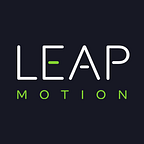5 Experiments from Leap Motion’s Internal Hackathon
This week on Medium, we’re travelling through time and space looking at the design behind our internal development projects — from our groundbreaking creative Sculpting app, to our introductory Playground, to our internal hackathon projects and the VR demos Planetarium and Cockpit.
Hackathons are a great way to jumpstart creativity, especially when honor and glory are on the line. This past summer, Leap Motion kicked off one of our internal hackathons, where small teams pitch and develop quick demos over the course of two days. After one of our engineers posted a video of AR Screen — a project using the Dragonfly module prototype to create an augmented reality work environment — the video soon got picked up and was later featured on Wired.
While none of the demos produced during the hackathon were intended to be polished products, we’re excited to see what these small teams were able to build over just 48 hours. We thought we’d take a closer look at some other projects from the hackathon.
Most Beautiful: AR Screen
Inspired by sci-fi interfaces, the AR Screen project was created by a few of our software engineers and a designer, using our public SDK alongside our prototype Dragonfly module. Built using C++/OpenGL, the project uses genuine Windows API calls to bring the interface into augmented reality.
During the video, you can see a blue glow effect, which is part of our Image Hands asset. Along with some basic UI interactions, the demo also lets you “turn down the lights” — making the real world fade away. You can learn more about how the demo works in our post Under the Hood: The Leap Motion Hackathon’s Augmented Reality Workspace, which includes lots of code samples.
Danger: Scooter Warpspeed
Originally imagined as an augmented reality demo that would detect your speed on a self-balancing electric scooter, Scooter Warpspeed also used the Dragonfly prototype. The project would display “warp speed” stars flying past you as you went forward on the scooter. (We have several of these scooters around the office and our engineers love them — pedestrians beware!)
Due to safety concerns, the team ultimately decided to make it into a sit-down space simulator where stars, comets, space dust, and planets fly past you. Occasionally, you get surrounded by a burst of thousands of stars.
Utility: Swipey Joe McDesktop
The simply titled Swipey Joe McDesktop took the top prize for utility — winning the Throne of Leaps (seen here alongside the Leap Motion Crown).
Built in Python, Swipey Joe McDesktop works as a service which translates hand gestures into triggered keyboard events, based on a customizable configuration file. The project has since been open sourced and can be found on GitHub (tested only on Linux).
Crowd Favorite: Scuba Trainer VR
Crowd Favorite was a tough contest, but ultimately the prize went to the educational app Scuba Trainer VR, which has since been added to our Developer Gallery. The demo guides you through the real-life steps of learning buoyancy control and putting on your regulator before diving into the water. But don’t sink or rise too fast, or you’ll suffer from equalization problems or decompression symptoms!
For their valiant efforts, the team was awarded the prized Leap Motion Crown (play for full effect):
Fun: SpaceLeap
Last but not least, we’re big fans of Spaceteam, a co-op multiplayer game that involves shouting instructions to other players. SpaceLeap was a gameplay homage that added a motion controlled VR twist to the core game mechanic. In fact, multiplayer was a mini-theme for the hackathon. We quickly discovered that this was a great way to guide new users through new inputs and interfaces.
What’s the Latest on Dragonfly?
We’ve gotten a lot of interest in the Dragonfly module, and we’re definitely excited about the possibilities of blurring the lines between imagination and reality. Right now, our main priority continues to be improving the core tracking software. There’s a lot of work ahead for our team, especially with consumer VR on the horizon, so we’re dedicating all possible resources to making that happen.
These software updates have major tracking benefits to all of our devices, from the Leap Motion Controller that people have right now, to the embeddable prototypes that will enable the next generation of VR, automotive, and other experiences. At the same time, there are smaller challenges, specific to Dragonfly, which need to be ironed out on the software level before we can fully support a wider developer release.
Nonetheless, after seeing what our teams could build in two days, we can’t wait to see what the VR community will build in the 3D Jam.
Top image credit: HBO
Originally published at blog.leapmotion.com on July 18, 2015.
